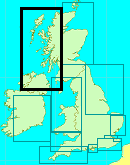You are viewing the expanded version of this Harbour,
for faster browsing
use the regular version here
Kirkcudbright, Marina and River Dee
Courtesy Flag
Flag, Red EnsignWaypoint
Kirkcudbright Bay 54:46'N 004:04'WCharts
Admiralty 1344Rules & Regulations
Pleasure boats to use pontoon, not Town Quay. Some berths dry outHazards
Approach up a twisting very shallow channel. Tidal streams up to 3.5 Kt.Tidal Data Times & Range
HW + 0030 Dover Kirkcudbright Bay MHWS 7.5m, MHWN 5.9m, MLWN 2.4m, MLWS 0.8mThis site is designed for slower, roaming broadband connections, like you would get at sea, so it needs JavaScript enabled to expand the text.
General Description
Contact Details:
Harbourmaster (Robbie Garside) VHF #12 & 16, Tel. No. 01557 331135 mobile 07709 479663
For yachts and motorboats heading north from the Cumbrian coast, Kirkcudbright may well be their first Scottish port of call.
The HM here asks that skippers intending to visit contact the mobile number at the planning stage and advise of their intended visit
Small craft Mariners are advised to give the Solway Firth a very good offing, but from say, Whitehaven, a course can be shaped up for Kirkcudbright Bay leaving the Solway Firth well off on your starboard side. It is most unwise to enter Solway Firth, an area of uncharted shallows, banks and strong tides.
The town of Kirkcudbright is reached via a twisting buoyed channel, with very little water in it. However once you arrive, the local council in charge of harbours in this area, have very thoughtfully provided a visitors pontoon where moderate draft craft may lay afloat at all states of the tide.
All normal smalltown facilities will be found here, and shelter is good. The tide can however flow in and out at speeds of up to 3.5 kn, so timing is essential.
There are also various anchorage spots, some where you may remain afloat, and others for drying out.
Kirkcudbright is a Dumfries and Galloway Council Harbour and an extremely useful and detailed Harbour Directory for all their harbours can be downloaded at www.dumgal.gov.uk/harbours
Approach
Small craft mariners should be mindful of the cross tides when planning their approach.
This will either be sweeping the boat towards the dangers of the Solway Firth, or out to sea. Cross tides can run at up to 4 Knts at springs.
Kirkcudbright Bay (54°46'N., 4°04'W.) is entered between Gipsy Point and Little Ross Island, 1.5 miles W. It has depths of 5 to 9m in the entrance and the approach is free from dangers with the exception of a detached 3.9m patch which lies about 0.2 mile W of Gipsy Point.
Little Ross Island is separated from the mainland by a narrow passage. A light is shown from a prominent structure, 20m high, standing on the E side of this island.
The River Dee flows into the head of the bay and connects with a narrow channel with a least charted depth of 0.3m over the bar. This channel passes through the drying sandbanks in the N part of the bay. Buoys marking the channel are moved without notice to conform with changes in the drying banks.
Ross Roads provides a passage anchorage, with good shelter from most winds other than S or SE. Be mindful of depths, and the rocky shallow patches shown on the chart.
Small craft can find complete shelter by pushing in to the River Dee, but they will need a sufficient rise of tide to attempt this.
There are least depths of 0.1 m shown in the approach to the Lifeboat House, therefore even at neaps it would be best to make your approach a couple of hours before high water. Bearing in mind that the tide in the River Dee can flow outward at speeds of up to 3.5 kn, it would be unwise to leave it too long after high water before making your approach up the river.
CHANGE 2021 The light on the lifeboat station (Fl 3s) has been reduced to a visible distance of 2nM for the forseable future.
A quick glance at the navigation will show that there is a transit on Little Ross Island to help craft find the deepest water in the approach to the Lifeboat House. Keep the lighthouse and the White Beacon in line behind you, on a course of 021° T.
This takes you to the Lifeboat House, and from here the channel is well buoyed. The buoys are often moved around to suit the channel, and light characteristics should not be relied on.
There is a Notice to Mariners in force (May 2021) saying that shoal water is suspected to the NE of Number 13 Buoy so don't cut the corner there.
You shouild be aware that the fishing fleet puts to sea as soon as they float at the Town Quay - which means you should be prepared to meet opposite direction traffic if you are running up on the last of the flood.
Once past St Mary's Isle, the channel is well defined and steep to on either side. The River swings to East once past Castledyke Point, and you'll be virtually on top of the Marina and the town.
Berthing, Mooring & Anchoring
Possible anchorages in the approach area are best seen by reference to the chart.
It should be possible to tuck yourself away to suit most conditions. Bear in mind at LWN there will be over 2 m more than shown on the chart. The drying Ross Bay, could offer very good shelter to those prepared to take the ground.
Those pushing up to Kirkcudbright will find an unmissable 300 m length of pontoon on the starboard side. Visiting yachts are accommodated here (and not on the Town Quay, which is reserved for the small fishing fleet). Most pleasure craft should remain afloat here, except for maybe exceptionally deep draft yachts at LWS, who may touch the muddy bottom. There is a report (May 2021) of shoal water to the South of the PHM No 26 opposite the marina
Marina charges(2022) here work out at £21.50 per night for boats up to 8 m, £26.50 per night for boats to 10 m, £32.50 per night the boat to 12 m. These prices are all in - including showers, shore power and VAT. If you plan to stay for a week you can get a 7 days for 5.
Facilities
The River pontoon provides shore access for visitors. Power and water are available here, together with showers and toilets ashore. There is a CCTV monitoring.
Fuel can be arranged by road tanker, while limited chandlery and repairs geared to fishing boats can be sorted out locally, see directory.
Kirkcudbright Sailing Club at the Marina welcomes temporary members. The club can also provide a slipway for trailer sailers with access at 1/4 of the tidal range. Details from Mark Nixon on 01557 870333.
Another launching place is at the Baity Timber Yard, on the East side of the River Dee, about 3 miles out of town. This slip has access at 1/2 the tidal range, there are small charges, best phone them first on 015557 330051.
This inlet is very reminiscent of the Helford River down in Cornwall; similar views etc.
The town itself can offer banks, post office, and all day-to-day provisioning. Transport wise there are no rail links, but Kirkcudbright is well served by buses.
More Info
History
Kirkcudbright, is a town in the south of Scotland in Dumfries and Galloway. The town lies south of Castle Douglas and Dalbeattie, in the part of Dumfries and Galloway known as the Stewartry, situated at the mouth of the River Dee, some six miles from the sea. It was the county town of the former county of Kirkcudbrightshire.
Some History
The early rendition of the name of the town was Kilcudbrit, derived from the Scottish Gaelic "Cille Chuithbeirt" (Chapel of Cuthbert), the saint whose mortal remains were kept here for seven years between exhumation at Lindisfarne and re-interment at Chester-le-Street.
Spottiswood, in his account of religious houses in Scotland, mentions that the Franciscans or Grey Friars had been established at Kirkcudbright from the 12th century. No traces of the Greyfriars or Franciscan dwellings remain in the parish of Kirkcudbright.
In 1453, Kirkcudbright became a Royal burgh , and about a century later the magistrates of the town obtained permission from Queen Mary to use part of the convent and nunnery as a parish church. From around 1570, Sir Thomas Maclellan of Bombie, the chief magistrate, received a charter for the site, its grounds, and gardens. Maclellan dismantled the church in order to obtain material for his proposed castle and proceeded to have a very fine house, MacLellan's Castle, built on the site.
After defeat at the Battle of Towton, Henry VI of England crossed the Solway in August 1461 to land at Kirkcudbright in support of Queen Margaret at Linlithgow. The town also successfully withstood a siege in 1547 from the English commander Sir Thomas Carleton, but after the surrounding countryside had been overrun was compelled to surrender.
The Tolbooth was built between 1625 and 1629 and served not only as the tollbooth, but also the council offices, the Burgh and Sheriff courts, the criminal prison, and the debtors' prison. One of its most famous prisoners was John Paul Jones, hero of the American navy, who was born in nearby Kirkbean.
The Kirkcudbright Railway opened in 1864, but the railway line and station closed in 1965.
Museum
The Stewartry Museum was founded in 1879 and was at first based in the Town Hall until it became too small. The collection moved to a purpose-built site and contains the local and natural history of the eastern part of Galloway, formerly known as Kirkcudbrightshire and now known as the Stewartry. Britain's earliest surviving sporting trophy, the Siller Gun , is part of the collection, as are paintings by many local artists.
The Tolbooth building is now used as an Arts Centre.
Artists
Kirkcudbright has had a long association with the Glasgow art movement, which started when a colony of artists, including the Glasgow Boys and the famed Scottish Colourists, such as Samuel Peploe and F. C. B. Cadell, based themselves in the area over a 30-year period from 1880 to 1910.
Many of them moved to the town from Glasgow, including E A Hornel, George Henry, and Jessie M King, and their presence led to Kirkcudbright becoming known as "the artists’ town", although this moniker may have originated more from tourist board publicity rather than local usage.
Cinema
The whodunit Five Red Herrings by Dorothy L. Sayers involves the artistic community of Kirkcudbright. In 1975, the book was made into a film shot in the town, with Ian Carmichael playing the lead role of Lord Peter Wimsey.
The town also featured in the cult 1973 horror film The Wicker Man. Several parts of the town can be easily recognised in the film.
http://en.wikipedia.org/wiki/Wikipedia:Text_of_the_GNU_Free_Documentation_License
Eating, Drinking & Entertainment
The compact town can offer a reasonable range of cafes, restaurants, and pubs. For a better idea of what's going on in Kirkcudbright, try this local website:
Links
|
Your Ratings & Comments









